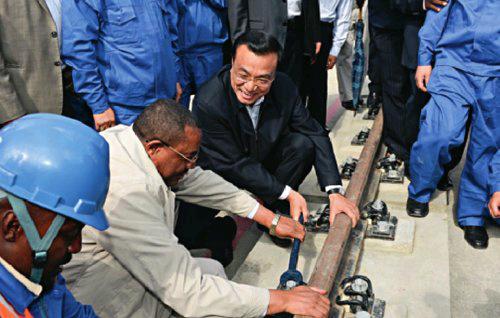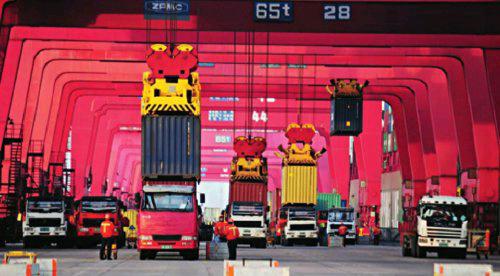China Steps Up Investments Abroad
By+LAN+XINZHEN
COULD Motorola reclaim its glory days? Many consumers pondered this question when Lenovo bought Motorola Mobility for US $2.91 billion in 2014. The acquisition brought the former internationally famous brand, which slipped into oblivion in the Internet era, back into the public eye.
Motorola was fortunate to receive a capital injection at its most difficult time. A number of companies, like Israeli dairy firm Tnuva, Canadian energy company Nexen, and the U.S. pork producer and processor Smithfield Foods, had the same experience. The past year alone saw a slew of cases of Chinese investments rescuing distressed foreign companies.
Data from Chinas Ministry of Commerce reveal that Chinese investors channeled capital into 6,128 overseas firms in 156 countries and regions in 2014. Its outbound foreign direct investment (OFDI) into non-financial sectors hit US $102.9 billion, up 14.1 percent year-on-year. Foreign direct investment(FDI) in China totaled US $119.6 billion, 1.7 percent higher than last year. Taking profit reinvestment and investment via third countries into account, Chinas OFDI was, for the first time, higher than the FDI, meaning that China has become an economy with a net capital outflow.
“This is a general rule for an open economy to develop to a relatively high level,” spokesman Sun Jiwen of the Ministry of Commerce said at a press conference.
The Wall Street Journal commented that despite its short history in OFDI, the importance of China is rising in this field – possibly second only to that of the U.S.
From Capital Receiver to Capital Exporter
When the policy of reform and open-ing-up was first launched in China, the country was badly in need of massive foreign capital to develop its economy. Hence, China was, for many years, a recipient of international industrial transfer. With the progress of its economy, China began to encourage domestic companies to invest abroad. When China joined the WTO at the end of 2001, its OFDI barely exceeded US $2 billion. But by 2014, the figure had increased nearly 40-fold. The country has become a major source of capital outflow. In 2013 and 2014, Chinas OFDI flows successively ranked third in the world.
Chinas overseas investment is gaining pace, which indicates a major shift in Chinese economic policy that used to focus on attracting foreign capital. China has grown into a major force of capital investments in the global market.endprint
According to the Report on Globalization of Chinese Enterprises (2014) published by the Center for China and Globalization (CCG), now is the prime time for Chinese firms to invest abroad. The economic recovery in developed countries and the revival of international investments provide a favorable climate for Chinese companies to go global. At the same time, Chinas economy is steadily growing and making progress in its economic restructuring, industrial transformation and upgrading, which supports the globalization of Chinese enterprises from within. Furthermore, in 2014, ministries including the National Development and Reform Commission(NDRC) and the Ministry of Commerce streamlined the approval process for overseas investment applications by domestic corporations, dismantling barriers in the course of their international ventures.
As CCG director Wang Huiyao pointed out, “Chinese enterprises are entering a new era in terms of globalization.”
Four Characteristics of Chinas OFDI
During its development, Chinas overseas investment has changed predominantly in four facets.
First of all, China is shifting its focus from less developed regions to relatively developed countries. Data from the Ministry of Commerce show that Chinas investment in developed countries grew fast in 2014, with a 23.9 percent increase in the U.S. and 1.7 fold in the EU. So far, mature markets like North America and Western Europe remain the most popular destinations for Chinese capital. The confidence in these markets is increasing and the Eurozone is recovering from recession. Therefore, merging with European companies at this time may enable Chinese investors to achieve wider market coverage while obtaining advanced technologies and management expertise at a lower cost.
Second, the area of investments is expanding. The going global strategy of Chinese enterprises initially aimed at rare resources and energy such as iron ore in Australia and Peru and copper in Kenya. Today, however, Chinese companies have ventured to wider areas like manufacturing, agriculture, culture and even infrastructure, which requires an enormous amount of capital.
According to the Ministry of Commerce, Chinas outbound investment in the service sector grew by 27.1 percent in 2014, pushing its share to 64.6 percent. TMT (technology, media and telecoms), minerals and resources, and real estate are the top three sectors in which Chinese companies have made M&A deals. TMT have especially gained more attention from Chinese investors, who are proactively seeking quality merger targets in mature markets, thereby bringing overseas technologies, brands, and intellectual properties into China.endprint
Third, OFDI by non-state-owned companies has surpassed that of stateowned enterprises (SOEs), which used to dominate this field. In recent years, private companies have played an active role in investments abroad and constantly increased their share of the OFDI flow: Geely bought Volvo; Fosun International bought a controlling stake in Portugals largest insurance group Caixa Seguros; Wanda Group acquired the worlds second-largest cinema chain AMC Entertainment, to name a few. In 2014, 56 percent of the total amount of Chinas OFDI was generated by nonstate-owned enterprises.
Last but not least, the Belt and Road Initiatives have become a driving force for Chinas OFDI. After the concept was put forward by China in 2013, the Asian Infrastructure Investment Bank and Silk Road Fund were established to provide financial support for collaborative projects among the countries involved with the initiatives in such fields as infrastructure, resource development, industry cooperation, and financial cooperation. In his speech at the CEO Summit of APEC meetings in November 2014, Chinese President Xi Jinping remarked that Chinas investment abroad in the next 10 years was expected to reach US $1.25 trillion. This implies that Chinas OFDI will grow threefold in this period from 2014, which is a precious opportunity for Chinese firms that intend to further expand into the overseas market.
Reliable Capital
It is widely known that Western countries often impose certain political conditions along with their overseas investments. Some developed countries prohibit or restrict investment by companies from certain developing countries whom they have blacklisted due to their domestic political situations.
Capital from China, in contrast, is reliable and friendly. China levies relatively few political restrictions on its investment destinations. Upholding the principle of mutual benefit, Chinese capital is invested in any projects that conform to international economic rules.
In the initial stage of its overseas investment, China mainly targeted resource-related industries. This led to accusations that China was exploiting other countries resources and acting as a “neocolonial” power in Africa. Meanwhile, in the U.S., critics worried that Chinas investment in the American continent and the Middle East would threaten Washingtons strategic interests.
In fact, Chinas OFDI is led by the market, which means that investing in the resource-related industries is simply natural market behavior. Today, Chinese investors want their capital to flow into a wider range of projects, such as shipping, high-speed rail, power equipment, telecommunications equipment, and communication devices, among many others. These are the areas in which China has technological advantages. Channeling capital and technology to where they are needed, Chinas investment is an act of sharing the fruits of progress rather than of aggression.endprint
Risks Come with Opportunities
The Mexican government on January 31, 2015 announced indefinite suspension of the high-speed rail project linking Mexico City with the industrial hub Querétaro, for which a Chinese-led consortium had won the tender. Although the NDRC immediately expressed the Chinese sides hope that the Mexican government could protect the legitimate rights of the Chinese companies and adopt active measures to promote pragmatic cooperation between the two countries, to what extent this response will be effective remains unclear.
This is not the only instance of Chinese enterprises encountering unpredictable risks ensuing from non-economic factors on their quest to go global. Earlier this year, Greeces newly elected government halted the privatization of the countrys biggest port, Piraeus, where Chinas shipping conglomerate COSCO was one of the bidders for a majority stake in the port authority. Similarly, the successful bid by a consortium made up of Chinese companies Shandong Hi-Speed Group and Friedmann Pacific Asset Management for a 49.99 percent stake in the Toulouse Blagnac Airport met with some objections in France.
Although the above countries have maintained good relationships with China over the decades, they are still cautious about Chinese capital. This indicates the rough road Chinese investors face to the global market.
The CCG survey shows that most Chinese enterprises are aware of the possible risks in the course of internationalization but have not yet taken effective preventive measures. At present, political and legal risks are the major threats to Chinese businesses venturing abroad. Among the 120 failed OFDI cases from 2005 to 2014 presented in the Report on Globalization of Chinese Enterprises(2014), a quarter was due to political reasons, eight percent was obstructed by political factions in the investee countries, and 17 percent suffered losses due to political instability, changes in the leadership and similar reasons in the investment destinations.
Zhang Yansheng, secretary general of the Academic Committee of the NDRC, points out that the impact of noneconomic factors is inevitable. Even a country like the U.S. that boasts a highly developed market economy cannot avoid non-economic constraints. Better handling of such problems requires more effort by investors and due government assistance. The government is advised to help firms diminish risks in noneconomic sectors through a more global vision.endprint

